Dilemma of the century. Do you take the advantages of raw or 4K? Do you take the full frame sensor or the crop? Do you take the DSLR form factor or the advantages for video of mirrorless?
This is something I’ve been really trying to draw a conclusion on in recent weeks for my own sanity!
I’ve been trying out a few looks recently. My favourite has been the 5D Mark III with 50mm F1.2L in raw and the Panasonic GH4 with Speed Booster.
With the 5D Mark III I have a real benchmark to aim for with my GH4 shooting. I want it to look like that but in 4K and with all the extra features on the Panasonic like the EVF.
For a long time Micro Four Thirds cameras have suffered from the small sensor perception, many people consider it inferior to full frame and aren’t willing to pay as much for the cameras or the lenses. Actually the GH4 is not that far off the Super 35mm cinema standard which when you compare it to full frame is also a ‘crop sensor’, yet nobody in the cinema world thinks of the Alexa as ‘small crop sensor’ do they?
The GH4 with Speed Booster actually renders the lens as a Super 35mm sized sensor would. An 18mm lens on it for example would be as wide as on the Alexa and a dreamy 35mm T2.0 would look the same too. But the Sigma 35mm F1.4 on full frame is something else entirely.
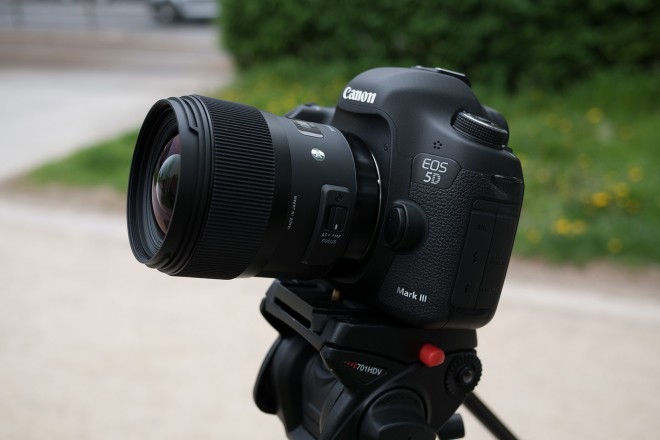
The 5D Mark III is the real oddity here but everyone seems to love the look. I certainly do. When I run 14bit raw through Resolve from that full frame sensor what always strikes me is colour. Canon put a lot of effort into colour science, not just with their L lenses and coatings but with their sensors as well. Between the APS-C Canon 50D and full frame 5D Mark II released only a small time apart something changed. Their CMOS sensors took a leap forward in colour reproduction and until now Panasonic had come nowhere near it with their sensors.
So I set out in this grade to match the GH4 to the 5D Mark III raw in terms of colour. I found it actually quite easy and a professional colourist could certainly have fine tuned specific things more, like the red channel especially which is handled differently on both cameras.
The lenses for this test were the Sigma 35mm F1.4 on the 5D Mark III and Sigma 18-35mm F1.8 + Metabones Speed Booster (Nikon mount) on the GH4. This test was shot with the standard Micro Four Thirds version of the Speed Booster, not the BMCC variant!
The GH4 is much closer than I thought it would be to the 5D Mark III in terms of colour, considering the compressed 8bit codec vs mighty 14bit raw. Dynamic range appears to be about the same too from my real-world tests, though these were not scientific.
Aliasing is less on the GH4 especially when the 4K image is delivered at 2K. And of course up-rezzing the 5D Mark III’s 1080p 200% to 4K shows off the fine detail advantage of the GH4 which is quite a leap though if anyone will notice it in a real viewing is another matter. At 2K they both produce very detailed, clean images with very few artefacts present.
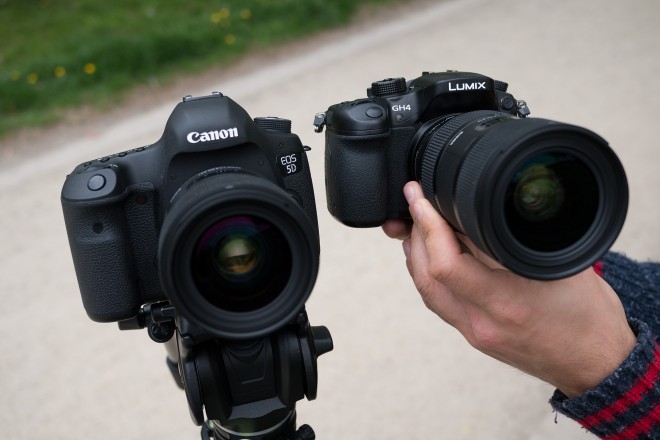
So which one do you get?
For me these are the ultimate cameras for the money right now.
If you can shoot with both, then do so. The footage will intercut very well.
If you can only use one or the other then the situation becomes rather more involved and there’s some differences you should know.
I think the GH4 is strongest with a fast and relatively long lens, say a 50mm F1.4 or 85mm F1.4 and punching in on the subject from further back. The 5D Mark III looks best in tight spaces and for when you want to exploit the look of full frame lenses to the max, with the swirling bokeh, shallow DOF and attractive vignette.
The fact is the GH4 even with Speed Booster will never render your 50mm F1.2L the way the 5D Mark III does. The closest I have got is to put the BMCC Speed Booster on the GH4 and use a Nikon 55mm F1.2, then move the camera back a bit to compensate for the crop of 1.4x in 4K, or 1.28x in 1080p mode. At equal focus distances the shallow depth of field is just as dreamy on the GH4 as it is on the 5D Mark III; the problem is that the field of view is narrower and moving the camera back from the subject to compensate changes the look to one that is flatter because you’re focused further towards infinity.
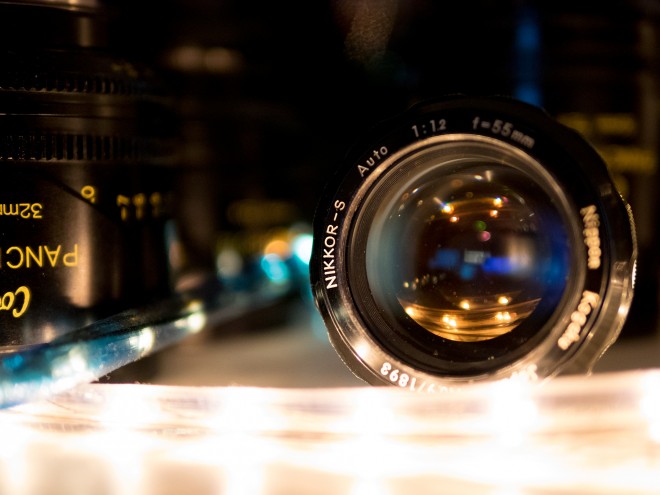
Canon 50mm F1.2L on full frame:
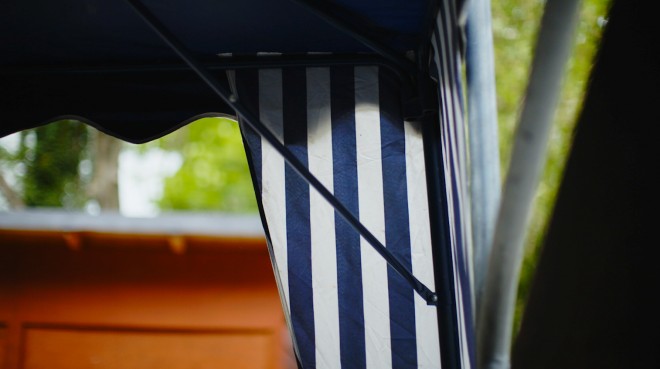
Nikon 55mm F1.2 on Metabones Speed Booster BMCC version (shot from same position):
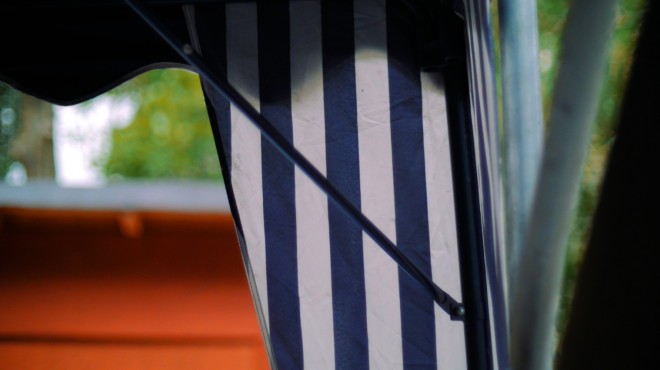
If you’re happy with the tighter framing on that shot then you have to say the rendering of the lens looks pretty similar!
However the issue is there are some shots that will suit the 5D Mark III’s rendering of the 50, and especially the rendering of wider angle lenses.
The answer to this problem for me is to shoot anamorphic. The GH4 simply comes alive with one, because it widens the field of view like having a wider sensor, while maintaining the properties of the fast aperture and longer focal length vertically from top of the frame to the bottom. This adds so much more character to the smaller sensor. This is what I have always done on the GH2 and will continue to do on the GH4.
In the end your decision should boil down to whether you need the resolution of 4K and what collection of lenses you plan to use…
- A full frame sensor will show the edges of your full frame lenses – and it is the imperfections that give an image character. A swirl in bokeh. A vignette or fall off towards the corners. Look at the Canon 24mm F1.4L and 50mm F1.2L shot wide open and you will see what I mean.
- Good quality glass on the GH4 tends to be more perfect from edge to edge, so you might want to add filters or a vignette in post to bring some character back into the image. The character of the bokeh will be the most different thing and you may want to use tighter framing if you really want to exaggerate background and foreground blur
- The GH4 with Speed Booster is a match to the look of Super 35mm but there’s no PL or Canon version of it yet which severely limits how useful it is for many users. I want to use my L series lenses and PL mount Cookes with Super 35mm characteristics on Speed Booster but still can’t yet!
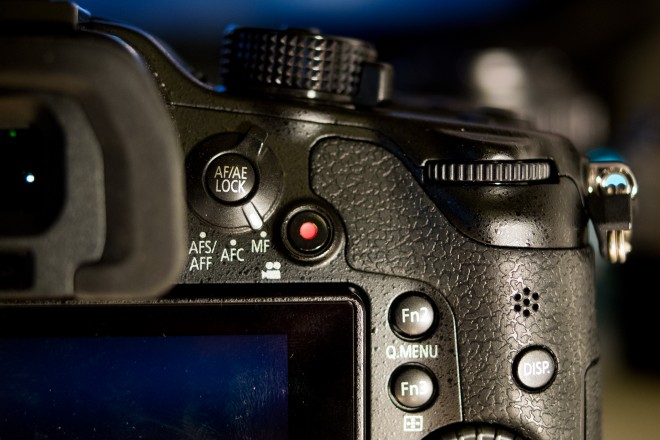
Ergonomics
In terms of form factor, the GH4 is certainly a win here. The articulated screen comes in invaluable on a tripod when you don’t want to add any rigging like an external monitor and the built in EVF is handy for handheld work. So good for bare-bones shooting. The 5D Mark III though does improve greatly for handheld work with a few tricks. Rather than rigging it up with rails and a shoulder mount I find it just as effective to use a gorilla pod to give me a huge number of contact points with the body for stability. Two from the back legs on my shoulders, one from the front leg acting as a handle to aim the camera (or the camera grip if preferred) and one from a loupe over the LCD held to the eye. On a tripod it does need a proper HDMI monitor adding really, not just for critical focus but to save your neck.
As for 5D Mark III raw and file sizes, these are manageable in post if you’re happy to throw away the raw files and only keep the ProRes 422. There’s very little image quality difference between the two actually. On the other hand the GH4’s image also grades surprisingly well for H.264, very close to ProRes and much closer to raw than the usual 1080p H.264 stuff because there’s just so much extra data in that 4K file. Yes it is compressed but not to the extent where compression becomes a big problem like on the Sony XAVC-S codec and the AX100. The GH4’s 4K file sizes are more like 1080p ProRes 422 yet are 4K. That is a very good job Panasonic have done with compression so it makes the camera very practical in that respect. No need to transcode the footage from raw to ProRes… you just directly edit and store the material as it comes off the card.
With the 5D Mark III find myself needing to take 5 or 6 cards around me even for a short shoot, and spend more time copying files off the cards and managing them on an external drive. The transcoding to ProRes in Resolve works fast at 40fps but this needs a RAID or SSD drive otherwise it slows down greatly. You can’t keep all your raw files on an SSD as the capacities aren’t large enough so the 5D Mark III is definitely the most expensive of the options. Not only is the body more expensive itself but the cards, editing rigs, drives, Canon L lenses and external monitor all add to it if you let it. The GH4 is more ready to shoot with out of the box, just pop a fast 35mm or 50mm on there and stand back from the subject, give the cropped sensor some room to breathe.
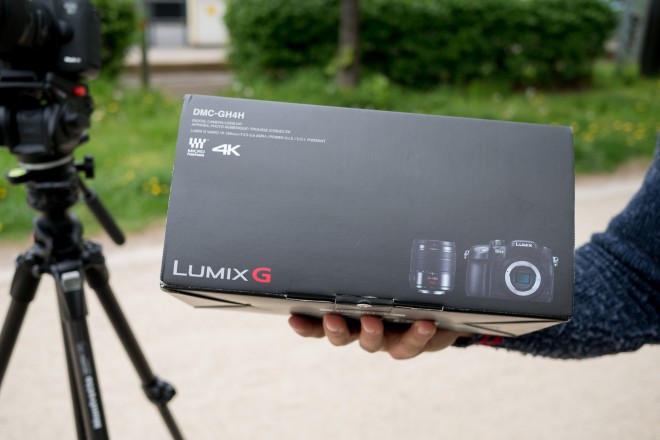
In the end the GH4 makes ultimate use of the glass you fit to it, so the image is only ever going to be as good as the shooter and the glass.
In the case of the 5D Mark III even a dog could get a good result with a Canon 50mm F1.2L on a full frame sensor, but the effort is transferred to post where you have to transcode, archive, file-manage the raw and colour correct it responsibly.
If you currently have neither camera, certainly the GH4 is the more accessible starting point. If you can afford a second body later on make it the 5D Mark III and that will give you an extra dimension to your lensing.


